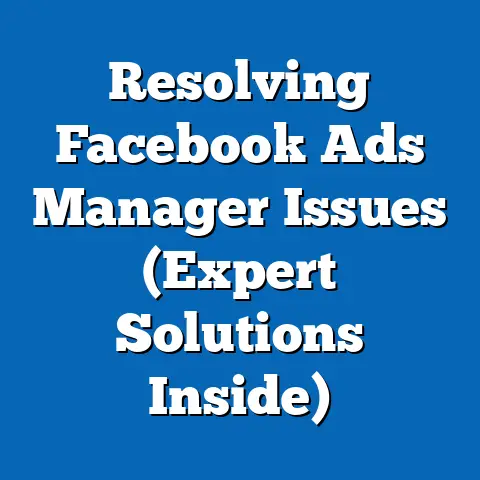Optimize Review Time for Facebook Ads (Proven Strategies)
In the breakneck world of digital advertising, time is truly money. A lengthy Facebook ad review process can feel like an eternity, holding up campaign launches, delaying crucial marketing efforts, and ultimately costing you revenue. Imagine crafting the perfect ad, targeting the ideal audience, and then… waiting. And waiting. And waiting, while your competitors scoop up potential customers. It’s a frustrating scenario I’ve personally experienced countless times throughout my years in digital marketing.
I’ve seen firsthand how these delays can derail even the most promising campaigns. Whether it’s a time-sensitive promotion, a flash sale, or a crucial brand awareness initiative, those precious hours (or even days!) spent in review can mean the difference between success and a missed opportunity.
Section 1: Understanding the Facebook Ads Review Process
Before we can optimize the review process, it’s crucial to understand how it works. It’s not just a black box where ads go in and approvals (hopefully) come out. There’s a method to the madness, and understanding that method is key to shortening your wait times.
1.1 Overview of the Review Process
Facebook’s ad review process is designed to ensure that all ads comply with its advertising policies and guidelines. This is to protect users from misleading, offensive, or harmful content, and to maintain a positive user experience on the platform. The process generally involves several stages:
- Initial Submission: When you submit your ad, it’s automatically queued for review. This initial stage involves automated checks.
- Automated Review: Facebook’s algorithms scan your ad copy, images, videos, and landing page for potential policy violations. This is the first line of defense, and it’s surprisingly sophisticated.
- Manual Review (Potentially): If the automated system flags your ad or if it’s a type of ad that requires closer scrutiny (like those dealing with sensitive topics), it may be sent for manual review by a human reviewer. This is where things can slow down considerably.
- Decision: Once the review is complete, Facebook will either approve your ad, reject it, or request changes.
- Appeal: If your ad is rejected and you believe it was a mistake, you have the option to appeal the decision.
It’s important to note that the review process isn’t always linear. An ad that initially passes the automated review might later be flagged for manual review if user reports or other factors raise concerns.
1.2 Common Reasons for Delays
Understanding the common pitfalls that lead to delays is half the battle. Here are some of the most frequent culprits:
- Policy Violations: This is the most common reason for ad rejections. Facebook has strict rules about what you can and can’t advertise, covering everything from health claims to political content.
- Unclear Messaging: Vague or misleading ad copy can raise red flags. Facebook wants to ensure that users understand what they’re clicking on.
- Inappropriate Content: Offensive, discriminatory, or violent content is strictly prohibited.
- Landing Page Issues: Your landing page must be relevant to your ad and comply with Facebook’s policies. Broken links, irrelevant content, or deceptive practices can lead to rejection.
- Technical Glitches: Sometimes, delays can be caused by technical issues on Facebook’s end.
- High Volume of Submissions: During peak advertising seasons (like the holidays), the review queue can get backed up, leading to longer wait times.
- Sensitive Categories: Ads related to finance, health, or politics often undergo stricter scrutiny and may take longer to review.
- Incorrect Targeting: Targeting audiences in a way that violates Facebook’s policies (e.g., discriminatory targeting) can lead to delays.
I remember one time when I was running a campaign for a weight loss product. I carefully crafted the ad copy, making sure to avoid any explicit health claims. However, the image I used showed a “before and after” transformation. The ad was immediately rejected because Facebook considered it a violation of their health and fitness policy. It was a valuable lesson in paying attention to every detail, not just the ad copy.
1.3 The Impact of Review Times on Advertising Success
Prolonged review times can have a significant impact on your advertising success, affecting everything from your budget allocation to your overall marketing strategy. Here’s how:
- Missed Opportunities: Delays can cause you to miss out on time-sensitive opportunities, like promotions, events, or seasonal campaigns.
- Wasted Budget: If your ads are delayed, you’re not reaching your target audience, and your budget is essentially sitting idle.
- Reduced ROI: Longer review times can lead to lower return on investment (ROI) as you’re not generating leads or sales as quickly as you could be.
- Impaired Campaign Performance: Delays can disrupt the momentum of your campaign, making it harder to achieve your goals.
- Increased Stress and Frustration: Dealing with ad rejections and lengthy review times can be incredibly frustrating and time-consuming, taking away from other important tasks.
- Damaged Brand Reputation: If your ads are consistently delayed or rejected, it can damage your brand’s reputation and erode trust with your audience.
- Difficulty Scaling: If you can’t rely on a consistent and timely review process, it’s difficult to scale your advertising efforts effectively.
Key Takeaway: Understanding the Facebook ad review process, knowing the common reasons for delays, and recognizing the impact of these delays on your advertising success are crucial first steps in optimizing your ad review time.
Section 2: Proven Strategies to Optimize Review Time
Now, let’s get to the heart of the matter: how to actually speed up the Facebook ad review process. I’ve compiled a list of proven strategies based on my own experiences and insights from other successful advertisers.
2.1 Pre-Submission Best Practices
The best way to reduce review times is to avoid problems in the first place. Meticulous pre-submission preparation can significantly increase your chances of a smooth and speedy approval.
Crafting Clear and Compliant Ad Copy
Your ad copy is often the first thing that Facebook’s algorithms (and human reviewers) will scrutinize. Here’s how to make sure it passes muster:
- Avoid “Red Flag” Words and Phrases: Facebook has a list of words and phrases that are automatically flagged as potential policy violations. These often relate to health claims, financial promises, or discriminatory language. For example, avoid phrases like “cure,” “guaranteed income,” or “targeting people based on their race.”
- Be Specific and Transparent: Clearly state what you’re offering and what users can expect when they click on your ad. Avoid vague or misleading language.
- Focus on Benefits, Not Claims: Instead of making direct claims about your product or service, focus on the benefits it provides. For example, instead of saying “This product will cure your acne,” say “This product can help improve your skin’s clarity.”
- Adhere to Grammar and Spelling Rules: Poor grammar and spelling can make your ad look unprofessional and raise suspicions. Proofread carefully before submitting.
- Avoid Exaggerated Claims: Don’t make promises that you can’t keep. Exaggerated or unrealistic claims can lead to rejection.
- Respect Copyright and Trademark Laws: Make sure you have the right to use any copyrighted material or trademarks in your ad copy.
I once had an ad rejected because I used the word “revolutionary” to describe a new software product. While I didn’t think it was an over-the-top claim, Facebook’s system flagged it as potentially misleading. I learned to be extra cautious with superlative adjectives and to focus on concrete features and benefits instead.
Visual Assets
Your images and videos are just as important as your ad copy. Here are some guidelines for using compliant visual assets:
- Use High-Quality Images and Videos: Blurry, pixelated, or poorly lit visuals can make your ad look unprofessional and raise red flags.
- Adhere to Facebook’s Dimensions and Specifications: Make sure your images and videos meet Facebook’s required dimensions and file sizes.
- Avoid Misleading or Deceptive Imagery: Don’t use images or videos that are irrelevant to your product or service, or that make false promises.
- Respect Copyright and Trademark Laws: Just like with ad copy, make sure you have the right to use any copyrighted material or trademarks in your visual assets.
- Avoid Sexually Suggestive or Explicit Content: Facebook has strict rules about sexually suggestive or explicit content in ads.
- Don’t Use Images That Promote Violence or Discrimination: Images that promote violence, hatred, or discrimination are strictly prohibited.
- Ensure Your Visuals Are Accessible: Consider adding alt text to your images to make them accessible to users with visual impairments.
Key Takeaway: Before submitting your ad, take the time to carefully review your ad copy and visual assets to ensure they are clear, compliant, and professional. This will significantly increase your chances of a smooth and speedy approval.
2.2 Utilizing Facebook’s Tools
Facebook provides several tools that can help you optimize your ad review time. These tools can help you identify potential issues before submission and streamline the ad creation process.
Facebook’s Ad Preview Tool
Facebook’s Ad Preview tool is a valuable resource for seeing how your ads will appear on different placements (e.g., mobile news feed, desktop news feed, Instagram feed). This allows you to catch any formatting issues or visual inconsistencies before submitting your ad for review.
- How to Use the Ad Preview Tool: When creating your ad in Ads Manager, you’ll see a preview section on the right-hand side of the screen. This allows you to see how your ad will look on different placements.
- Benefits of Using the Ad Preview Tool:
- Identify Formatting Issues: Catch any issues with your ad’s layout or appearance before submission.
- Ensure Visual Consistency: Make sure your images and videos look good on all placements.
- Check for Broken Links: Verify that all links in your ad are working correctly.
- Get a Second Opinion: Share the preview with colleagues or friends to get their feedback before submitting.
- Identify Formatting Issues: Catch any issues with your ad’s layout or appearance before submission.
- Ensure Visual Consistency: Make sure your images and videos look good on all placements.
- Check for Broken Links: Verify that all links in your ad are working correctly.
- Get a Second Opinion: Share the preview with colleagues or friends to get their feedback before submitting.
I always use the Ad Preview tool before submitting any ad. It’s saved me from countless embarrassing formatting errors and broken links. It’s a quick and easy way to ensure that your ad looks its best on all placements.
Automated Ad Features
Facebook offers several automated ad features that can help streamline the ad submission process and reduce review times.
- Dynamic Ads: Dynamic ads automatically show the most relevant products to each user based on their browsing history and interests. This can help you create more personalized and engaging ads, which are less likely to be flagged for review.
- Campaign Budget Optimization (CBO): CBO automatically optimizes your campaign budget across different ad sets to get the best results. This can help you avoid manual adjustments that might trigger a review.
- Advantage+ Campaign Budget: This feature takes CBO to the next level by using machine learning to automatically optimize your budget and bidding strategies. It can help you get the most out of your ad spend while minimizing the risk of review delays.
By leveraging these automated features, you can reduce the amount of manual work required to create and manage your ads, which can lead to faster review times and better overall campaign performance.
Key Takeaway: Take advantage of Facebook’s Ad Preview tool to catch any formatting issues before submission. Explore automated ad features like Dynamic Ads and Campaign Budget Optimization to streamline the ad creation process and reduce review times.
2.3 Efficient Communication with Facebook Support
Sometimes, despite your best efforts, your ads may still be delayed or rejected. In these cases, efficient communication with Facebook support is crucial.
Utilizing Facebook Business Support
Facebook Business Support can be a valuable resource for resolving review issues quickly. Here’s how to make the most of it:
- How to Contact Facebook Business Support: You can access Facebook Business Support through the Help Center in Ads Manager.
- Be Prepared with Information: Before contacting support, gather all the relevant information about your ad, including the ad ID, campaign ID, and any error messages you received.
- Be Clear and Concise: Clearly explain the issue you’re experiencing and what you’re hoping to achieve.
- Be Patient and Professional: Remember that the support team is there to help you. Be patient and professional in your communication.
- Follow Up: If you don’t hear back from support within a reasonable time frame, follow up to check on the status of your request.
I once had an ad rejected because Facebook’s system incorrectly identified it as promoting a prohibited product. I contacted Facebook Business Support, provided them with the necessary information, and explained why I believed the rejection was a mistake. They reviewed my case and quickly overturned the decision. It was a reminder that sometimes, human intervention is necessary to resolve issues.
Leveraging Community Resources
In addition to Facebook Business Support, there are several community resources that can provide insights and solutions from other advertisers who have faced similar issues.
- Facebook Community Forums: Facebook’s community forums are a great place to ask questions, share experiences, and learn from other advertisers.
- Facebook Groups: There are many Facebook groups dedicated to Facebook advertising. These groups can be a valuable source of information and support.
- Online Forums and Blogs: Many online forums and blogs cover Facebook advertising. These resources can provide helpful tips and insights.
By engaging with these community resources, you can learn from the experiences of others, find solutions to common problems, and stay up-to-date on the latest Facebook advertising trends.
Key Takeaway: When facing ad review issues, utilize Facebook Business Support and leverage community resources to find solutions quickly. Be prepared with information, communicate clearly, and be patient and professional in your interactions.
2.4 Keeping Up with Policy Changes
Facebook’s advertising policies are constantly evolving. Staying informed about these changes is crucial for avoiding ad rejections and delays.
Staying Informed
Here are some methods for staying updated on Facebook’s advertising policies:
- Subscribe to Facebook’s Business Newsletter: Facebook’s Business Newsletter provides updates on new features, policy changes, and best practices.
- Follow Key Figures in the Industry: Follow industry experts and thought leaders on social media and blogs.
- Regularly Review Facebook’s Advertising Policies: Make it a habit to regularly review Facebook’s advertising policies to ensure that your ads are compliant.
- Attend Industry Events and Webinars: Industry events and webinars can provide valuable insights into the latest Facebook advertising trends and policy changes.
- Join Online Communities: Join online communities of Facebook advertisers to stay informed about the latest news and updates.
I make it a point to review Facebook’s advertising policies at least once a month. It’s a small investment of time that can save you a lot of headaches down the road.
Implementing a Check-List System
To ensure that your ads are compliant with Facebook’s advertising policies, it’s helpful to create a checklist of compliance factors to review before submitting your ads.
- Create a Checklist: Create a checklist that covers all the key aspects of Facebook’s advertising policies.
- Review the Checklist Before Submission: Before submitting your ads, review the checklist to ensure that you’ve addressed all the compliance factors.
- Update the Checklist Regularly: As Facebook’s advertising policies change, update the checklist to reflect the latest requirements.
Key Takeaway: Stay informed about Facebook’s advertising policy changes by subscribing to newsletters, following industry experts, and regularly reviewing the policies. Implement a checklist system to ensure that your ads are compliant before submission.
2.5 Testing and Iteration
Testing and iteration are crucial for optimizing your ad review time. By running A/B tests and gathering feedback, you can identify compliant ad formats more rapidly and avoid unnecessary delays.
A/B Testing for Faster Approval
A/B testing involves running different versions of your ad to see which one performs best. This can also help you identify compliant ad formats more rapidly.
- Create Multiple Ad Variations: Create several different versions of your ad, varying the ad copy, images, and targeting options.
- Run A/B Tests: Run A/B tests to see which ad variations perform best.
- Analyze the Results: Analyze the results of your A/B tests to identify compliant ad formats that resonate with your audience.
- Focus on Compliant Elements: Once you’ve identified compliant elements, focus on incorporating them into your future ads.
I once ran an A/B test on two different ad images for a clothing store. One image showed a model wearing the clothes, while the other showed the clothes on a mannequin. The ad with the model was rejected because Facebook’s system flagged it as potentially violating their body image policy. The ad with the mannequin, however, was approved without any issues. This taught me that sometimes, seemingly innocuous images can trigger a review.
Gathering Feedback
Gathering feedback from peers or mentors on your ad drafts can help you catch potential issues early.
- Share Your Ad Drafts: Share your ad drafts with colleagues, friends, or mentors.
- Ask for Feedback: Ask for feedback on the ad copy, images, and targeting options.
- Incorporate the Feedback: Incorporate the feedback you receive into your ads.
Key Takeaway: Run A/B tests to identify compliant ad formats more rapidly. Gather feedback from peers or mentors on your ad drafts to catch potential issues early.
2.6 Case Studies of Successful Optimization
To illustrate the effectiveness of these strategies, let’s look at some real-life examples of businesses that successfully reduced their ad review times.
- Case Study 1: E-commerce Store
- Challenge: An e-commerce store selling fitness apparel was experiencing frequent ad rejections due to policy violations related to body image.
- Solution: The store implemented a checklist system to ensure that all ads complied with Facebook’s advertising policies. They also started running A/B tests to identify compliant ad formats.
- Results: The store reduced their ad review times by 50% and increased their ad approval rate by 30%.
- Case Study 2: Local Restaurant
- Challenge: A local restaurant was struggling to get their ads approved due to vague and misleading ad copy.
- Solution: The restaurant started crafting clear and compliant ad copy that focused on the benefits of their food and service. They also started using Facebook’s Ad Preview tool to ensure that their ads looked good on all placements.
- Results: The restaurant reduced their ad review times by 40% and increased their ad click-through rate by 20%.
- Case Study 3: SaaS Company
- Challenge: A SaaS company was experiencing delays in their ad review process due to the complexity of their product.
- Solution: The company started utilizing Facebook’s automated ad features, such as Dynamic Ads and Campaign Budget Optimization, to streamline the ad creation process. They also started engaging with Facebook Business Support to resolve any issues quickly.
- Results: The company reduced their ad review times by 60% and increased their lead generation by 25%.
- Challenge: An e-commerce store selling fitness apparel was experiencing frequent ad rejections due to policy violations related to body image.
- Solution: The store implemented a checklist system to ensure that all ads complied with Facebook’s advertising policies. They also started running A/B tests to identify compliant ad formats.
- Results: The store reduced their ad review times by 50% and increased their ad approval rate by 30%.
- Challenge: A local restaurant was struggling to get their ads approved due to vague and misleading ad copy.
- Solution: The restaurant started crafting clear and compliant ad copy that focused on the benefits of their food and service. They also started using Facebook’s Ad Preview tool to ensure that their ads looked good on all placements.
- Results: The restaurant reduced their ad review times by 40% and increased their ad click-through rate by 20%.
- Challenge: A SaaS company was experiencing delays in their ad review process due to the complexity of their product.
- Solution: The company started utilizing Facebook’s automated ad features, such as Dynamic Ads and Campaign Budget Optimization, to streamline the ad creation process. They also started engaging with Facebook Business Support to resolve any issues quickly.
- Results: The company reduced their ad review times by 60% and increased their lead generation by 25%.
These case studies demonstrate that by implementing the strategies discussed in this article, businesses can significantly reduce their ad review times and improve their overall advertising performance.
Key Takeaway: Learn from the experiences of others by studying case studies of successful optimization. Implement the strategies that have worked for other businesses in your industry.
Conclusion
Optimizing review times for Facebook ads is crucial for maximizing your advertising efficiency and achieving better results. By understanding the Facebook ad review process, implementing pre-submission best practices, utilizing Facebook’s tools, communicating efficiently with support, keeping up with policy changes, and testing and iterating your ads, you can significantly reduce your ad review times and get your campaigns up and running faster.
I encourage you to take immediate action on these strategies to see improvements in your advertising efforts. Start by reviewing your current ad creation process and identifying areas where you can improve. Implement a checklist system to ensure that your ads are compliant with Facebook’s advertising policies. Utilize Facebook’s Ad Preview tool to catch any formatting issues before submission. Engage with Facebook Business Support and leverage community resources to resolve any issues quickly.
Remember, optimizing review times is an ongoing process. By continuously monitoring your ad performance and staying up-to-date on the latest Facebook advertising trends, you can ensure that your ads are always compliant and effective. With a little effort and attention to detail, you can significantly reduce your ad review times and achieve better results with your Facebook advertising campaigns. So go forth, optimize, and watch your campaigns soar!





